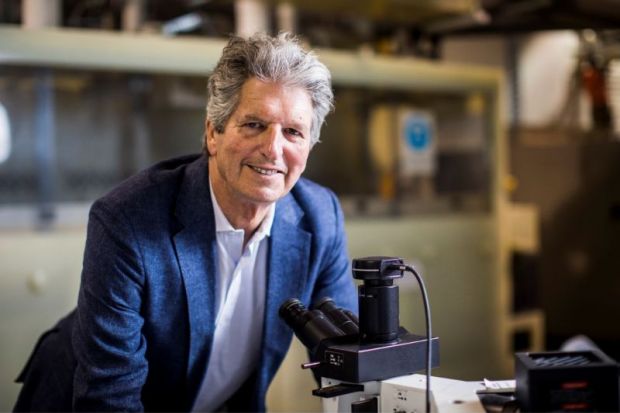Australia has been gripped by a rooftop revolution. Solar panels have transformed streetscapes like rows of mirror sunglasses. Solar farms have sprouted from the inland plains like glass and aluminium vineyards, producing enough electricity to power tens of thousands of homes.
The academic most responsible for this is Martin Green, Scientia professor of engineering at the University of New South Wales. In 2000, one of his doctoral students, Shi Zhengrong, decided to start manufacturing solar cells “against the odds” in his native China.
Dr Shi went on to be known as the “Sun King” and the “world’s first solar billionaire” after the firm he had co-founded, Suntech, listed on the New York Stock Exchange in 2005. It was the first private Chinese company to do so, in the biggest technology float of the year.
“The timing was perfect,” Professor Green said. “He was the right guy at the right time. That kick-started the whole Chinese industry, which is why we have cheap cells now.”
For Professor Green – who helped ring the bells for the 2005 float, along with his wife – it was a landmark moment in a career that had already spanned three decades, after he switched to solar from microelectronics in the 1970s.
“I thought, ‘Is this real work for a grown man?’ The only application I could see was better TV sets. I thought I’d like to do something a bit more challenging.”
For decades, Professor Green and his team made incremental improvements to solar cell technology, boosting their efficiency from 17 per cent in 1983 to 25 per cent in 2008. In the process, they spawned a new type of cell which now dominates the global silicon cell market.
The group has held the record for silicon cell efficiency for 30 of the past 35 years, he added, with its achievements certified by independent testing authorities. “That’s been a real help to us,” Professor Green said. “Any silly bugger can just say they’ve got a new record.
“When we go for grant funding, overseas people know we’re doing best because of these certified measurements. That really helped us maintain funding into the group over those decades.”
Professor Green was talking to Times Higher Education during what turned out to be Australia’s hottest January ever, with average temperatures across the continent exceeding 30°C for the first time ever.
Wild horses expired from heat stress. Snakes sought refuge in people’s toilets. Fires raged in Tasmanian forests normally too wet to burn. Monsoons inundated thousands of homes in a Queensland city renowned for its dryness – examples, in short, of the types of unpredictable weather climate scientists have long warned us about.
Professor Green said he had doubted that climate change’s doomsday scenarios could be averted. Since 2016, rapid drops in the cost of producing solar energy have changed his mind.
“I was pessimistic a few years ago,” he said. “Solar was going to need help to gain significant market share. It was going to require some political action. Now, it’s just economics.”
He cited a 2017 pledge by a Saudi solar company to produce electricity for 1.8 US cents (1.4 pence) a kilowatt hour. “Nothing could come close to matching that,” he said.
“The cheapest bid anyone has had for a new coal-fired power station was 5.7 cents a kilowatt hour. Solar is way cheaper now. One of the reasons has been that in the past it was regarded as uncertain technology and the banks were charging extra high interest to install these solar systems.
“The tables have turned. No one wants to invest in a coal-fired plant, so they’ve got to pay high interest rates. Solar is getting financed by green bonds – [by] people not expecting the return you’d get from a dirty bond.”
Real-world industry reflects the professor’s optimism. Last year, 25 large-scale solar projects were commissioned across Australia – compared with just four the previous year – with a further 59 planned or under construction, according to Australia’s Clean Energy Council.
However, not everyone is convinced. Last year, when Professor Green collected the latest of his many awards, Russia’s Global Energy Prize, there was a possibility that it would be presented by Vladimir Putin. Instead, the award – which comes with 39 million roubles (£460,000) of prize money and was shared with Sergey Alekseenko, a professor at Novosibirsk State University – was handed over by energy minister Alexander Novak.
Mr Putin, however, had addressed a forum the previous day. “He was denying climate change and wanted Russia to get into coal export,” Professor Green said. “Apparently they’re not doing enough coal exporting. He thought climate change was due to cosmic rays nucleating more water vapour in the atmosphere, and clogging up the escape hatch.”
Professor Green said the award had been presented during a Russian energy week event replete with oil and gas “bigwigs” talking up the gas pipeline to Europe. “I was trying to tell them that in five years they will be installing solar, even though they’ve got bugger all sunshine there.”
john.ross@timeshighereducation.com
Martin Green will be speaking at the Times Higher Education Research Excellence Summit: Asia-Pacific at the University of New South Wales from 19 to 21 February.
后记
Print headline: Supervisor basks in rays of hope




